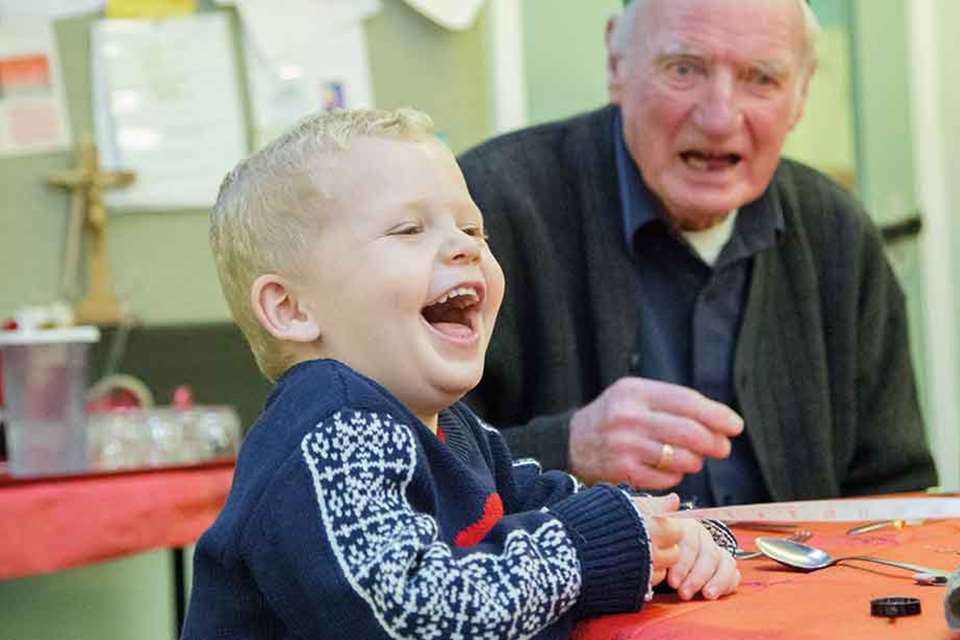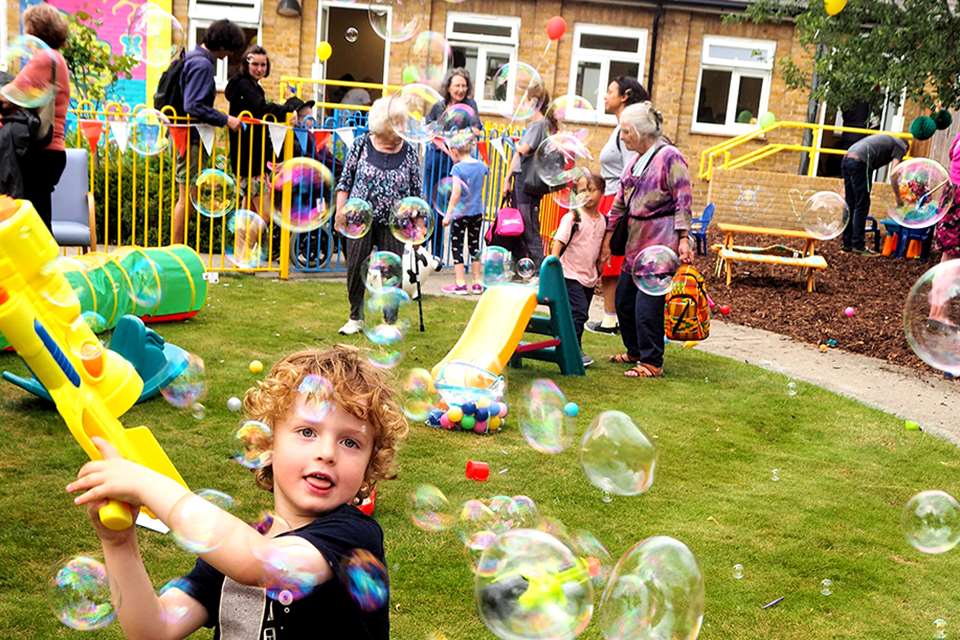Learning & Development: Intergenerational Practice - Spring chickens
Meredith Jones-Russell
Monday, July 24, 2017
A project linking a nursery to a care home is improving well-being for young and old alike, discovers Meredith Jones-Russell

Fullbrook Nursery School in the West Midlands has developed an intergenerational project called Spring Chickens, in partnership with its local residential care home Delves Court.
The six-week project sees a group of eight children visit the nearby residential home for the elderly for 45-minute activity sessions once a week, to help enhance the well-being of both the children and the residents of the home.
Andrina Flinders, the head teacher of the school, says the idea came after one of the nursery practitioners watched a TV documentary about the benefits of teenagers working with the elderly.
‘We used to go over to the local residential home for singing, but we wanted to make a more purposeful impact on both the children and the elderly residents,’ she explains. ‘We did some Googling and found a lot about the benefits for teenagers but less for young children.
‘Our nursery is in an area of deprivation and we have a lot of children with communication and language delay, as well as limited experience of their local community. We know exposure is important, and that we need to open up ways to inspire natural curiosity and talking.
‘On our one-off visits to the home in the past we quite often didn’t even take our coats off. We would sing, have a biscuit and a drink, and leave. So we felt that repetition was definitely needed to gain familiarity.’
 Eight children were selected to take part in the project, each of whom was assessed to be at risk of communication delay based on the results of a speech and language screening tool score, or who had personal, social and emotional development levels lower than expected for their age group.
Eight children were selected to take part in the project, each of whom was assessed to be at risk of communication delay based on the results of a speech and language screening tool score, or who had personal, social and emotional development levels lower than expected for their age group.
Eight residents of the care home were also selected based on criteria such as their suitability to work with children, but also prioritising those who were especially vulnerable, for example, residents found to be prone to depression.
‘We made sure the children and residents were always sat on the same table so they could get to know each other,’ says Ms Flinders. ‘By week three the whole atmosphere was much more relaxed.’
WORKING TOGETHER
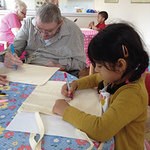 Each session featured a different activity, chosen in discussions between the nursery and care home staff before the project began. ‘We thought about what would stimulate talking and working together and came up with collaborative activities that would be mutually beneficial,’ says Ms Flinders.
Each session featured a different activity, chosen in discussions between the nursery and care home staff before the project began. ‘We thought about what would stimulate talking and working together and came up with collaborative activities that would be mutually beneficial,’ says Ms Flinders.
‘We wanted activities for old and young. For example, we knew the residents would remember playing dominoes, but at the nursery we have really huge ones for use in a group, and rather than dots we have animals on them, so they were easier for the residents to see.
‘We also got them doing sensory activities like using scented playdough, which the children could enjoy but also let the older people exercise their fingers.’
The sessions were structured so that activities could build on the developing relationships. Ms Flinders explains, ‘At first we started with activities that were less collaborative and mainly involved food, for example decorating fairy cakes together, to make sure the children would want to go back the next week because they thought they would get more cake! Then nearer the end of the project we did activities like hand painting which were more collaborative, making one canvas for the care home and one for the nursery to keep and display.’
SOMETHING TO REMEMBER
Ms Flinders continues, ‘At nursery we usually do less product-led and more project-led tasks, but we wanted the children and the residents to have something to show for their time together, and also have something to show or give to their new friends. So, they made picture frames and decorated tote bags, some of which are still on the backs of some of the residents’ wheelchairs, and they also decorated plant pots and planted bulbs, which are still growing in the nursery.
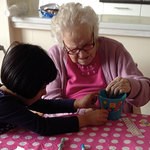 ‘We felt it was also important that the children had something to take home and show their parents, who were very impressed with their plant pots and proud of their child being able to contribute to the well-being of the residents.’
‘We felt it was also important that the children had something to take home and show their parents, who were very impressed with their plant pots and proud of their child being able to contribute to the well-being of the residents.’
The nursery sent out letters to parents at the start of the project detailing the aims and explaining why the children had been chosen, emphasising the mutual benefit to the children and the residents. At the end of the project, parents and residents came into the nursery for afternoon tea to meet each other and look at photographs taken during the nursery’s visits to the home.
An activity co-ordinator from the residential home says, ‘It became the highlight of the residents’ week that they looked forward to with excitement and enthusiasm. They talked about it for weeks after the project finished.’
HELP AND ENCOURAGEMENT
Ms Flinders says working with vulnerable adults especially helped the children to develop both their empathy and understanding skills.
‘It was like the children almost sensed the residents were more vulnerable, and it made it easier for them to talk,’ she explains.
‘The children selected weren’t originally showing much curiosity, but they started asking questions, like whether the old people were nannies or grandads, and giving compliments on the activities they were doing and encouraging them to keep going. The staff had to hold back tears a few times when they saw the children offering that support, saying “that’s a lovely picture” or “well done” to the residents.
‘They also helped a lot, for example, when they played with stickers and the children offered to peel the backs off for some of the residents whose hands didn’t work so well.’
TRACKING OUTCOMES
The school uses the Leuven well-being and involvement scales to measure results of the project. The group of eight children began with an average score of 3.5 out of five, and by the end of the six weeks had an average of 4.9.
‘Of course, this is only a six-week intervention – they are part of other groups too which will have had an effect,’ says Ms Flinders. ‘But the project undoubtedly contributed to children’s well-being and their communication skills, as well as their understanding of the world. It got them asking questions about the world around them, other communities and other people.’
Fullbrook plans to run the project again on a termly basis, with a new group of children selected each time. Ms Flinders says she is looking forward to the project continuing, but can foresee one problem. ‘Of course, the children move on from the nursery, but the residents don’t. The activity co-ordinators at the home have said they will choose new participants for next time too, but apparently that hasn’t gone down very well with the residents, who all want to be involved again.’
CASE STUDY
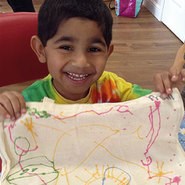 Prem was chosen to be part of the project in order to support his personal, social and emotional development, well-being and involvement levels, and to nurture his inquisitiveness about the world.
Prem was chosen to be part of the project in order to support his personal, social and emotional development, well-being and involvement levels, and to nurture his inquisitiveness about the world.
On entrance to the school, Prem scored low on the Leuven well-being and involvement scales and needed extra support to feel secure in the nursery routine. He observed other children closely as he played alongside them, but rarely initiated interaction.
As each week of the project went by, Prem’s confidence, well-being and engagement with others around him grew. Initially, this was only evident during visits to the care home, where Prem built a relationship with one resident in particular, who after the second week he would run to sit next to. He began to respond when his elderly friend asked him questions and soon began to ask his own questions.
By the third week, Prem’s new confidence began to spill over into nursery. He became much more independent and active in his learning, and started to initiate socialisations. During his last visit to the home, Prem even entertained all the residents with a song and dance.
As part of the evaluation of the project, his mother said, ‘Prem has been far more open in talking about Delves Court than the one-word answers he used to give, and he was so excited to share all the lovely things he had made.’
As he transitions to primary school he is on track to achieve a good level of development at the end of the Foundation Stage, and has gained confidence and social skills.
MORE INFORMATION
The Leuven scales for emotional well-being and involvement were developed by Professor Ferre Laevers at Leuven University in Belgium. The five-point scales measure emotional well-being, or the extent to which pupils feel at ease, act spontaneously and show self-confidence, as well as level of involvement, which focuses on the extent to which pupils are focused, engaged and interested in activities. The theory behind the scales suggests that unless pupils are working at the top levels of four or five, learning will be limited – though it acknowledges that levels will fluctuate. See:www.earlylearninghq.org.uk/earlylearninghq-blog/the-leuven-well-being-and-involvement-scales



